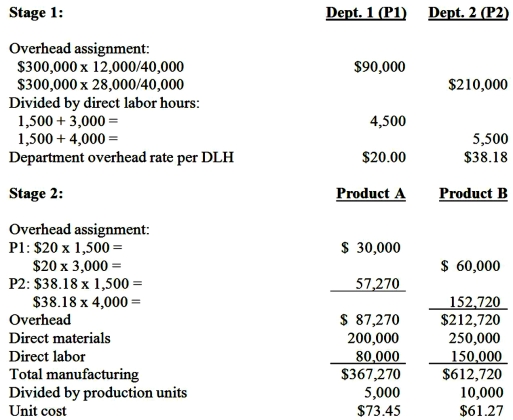Demski Company has used a two-stage cost allocation system for many years.In the first stage, plant overhead costs are allocated to two production departments, P1 and P2, based on machine hours.In the second stage, Demski uses direct labor hours to assign overhead costs from the production departments to individual products A andB.
Budgeted factory overhead costs for the year are $300,000.Both the budgeted and actual machine hours in P1 and P2 are 12,000 and 28,000 hours, respectively.
After attending a seminar to learn the potential benefits of adopting an activity-based costing system (ABC), Ted Demski, the president of Demski Company, is considering implementing an ABC system.Upon his request, the controller at Demski Company has compiled the following information for analysis:
 Demski manufactures two types of product, A and B, for which the following information is available:
Demski manufactures two types of product, A and B, for which the following information is available:
Required:
1.Determine the unit cost for each of the two products using the traditional two-stage allocation method.Round calculations to 2 decimal places.
2.Determine the unit cost for each of the two products using the proposed ABC system.
3.Compare the unit manufacturing costs for product A and product B computed in requirements 1 and 2.
(a) Why do two the cost systems differ in their total cost for each product?
(b) Why might these differences be important to the Demski Company?
Answer may vary
Feedback: 1.Unit cost for each of two products using the traditional two-stage allocation method:

Correct Answer:
Verified
View Answer
Unlock this answer now
Get Access to more Verified Answers free of charge
Q126: Plant overhead for ABC Corp in $150
Q127: The controller for Alabama Cooking Oil
Q128: Classify each of the following costs as
Q129: Pasternik Company produces and sells two
Q130: Swenson Company manufactures 4,000 units of
Q132: Two students in a cost accounting class
Q133: Scott Cameras produces digital cameras and have
Q134: Nerrod Company sells its products at $500
Q135: Nerrod Company sells its products at $500
Q136: asternik Company produces and sells two
Unlock this Answer For Free Now!
View this answer and more for free by performing one of the following actions

Scan the QR code to install the App and get 2 free unlocks

Unlock quizzes for free by uploading documents